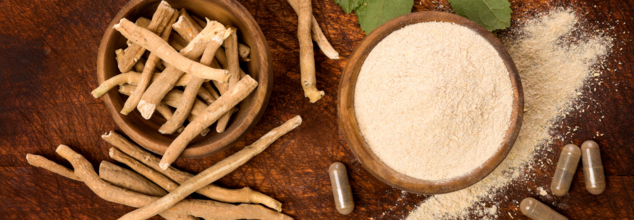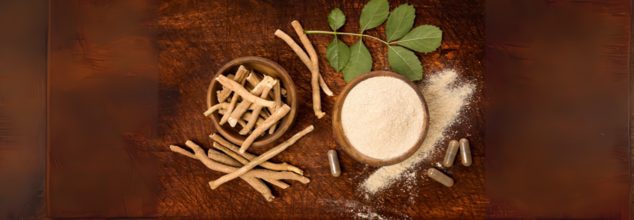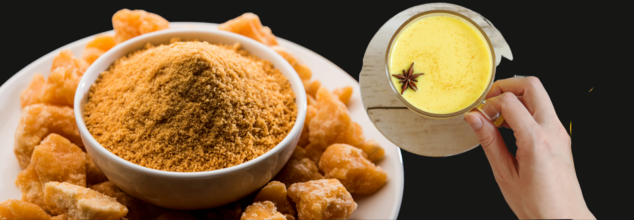- Health Conditions A-Z
- Health & Wellness
- Nutrition
- Fitness
- Health News
- Ayurveda
- Videos
- Medicine A-Z
- Parenting
- Web Stories

(Credit-Canva)
Ayurvedic Stress Reliever You Should Add To Your Diet
Ayurveda offers not just learnings like how to live your life in a healthy manner, cures and other aspects of life, but it also offers knowledge of different herbs. Nature has given us many cures, if there is a bodily issue, there is a natural way to treat it or its symptoms. Many ayurvedic procedures were also the true bases of modern day treatments.
Many of these herbs and treatments are still in practice, mostly through word of mouth and familial practices in India. However, not many people know how or why these herbs are important. One such herb is Ashwagandha. It is a plant that looks like a small tree and grows in countries in Asia and Africa. People often use it to help with stress. However, scientists haven't found much strong proof that it works as an "adaptogen," which is something that's supposed to help your body handle stress better.
How Does Ashwagandha Affect The Body?
This plant contains different chemicals that could have effects on the body. According to a study published in 2019 Cureus, some of these chemicals might help calm the brain, reduce swelling, lower blood pressure, and even change how your body's defense system (the immune system) works. Scientists are still studying exactly how these chemicals affect the body.
Ashwagandha has been traditionally used as an adaptogen, meaning people have used it for many problems they think are related to stress. These include things like trouble sleeping, getting older, feeling anxious, and many other health issues. A 2021 in the Current Neuropharmacology showed that Ashwagandha or Withania somnifera (WS) extract exhibited anti-anxiety and anti-stress in animals and human studies. It also improved the symptoms of depression and insomnia; however, these claims need to be studied more.
Research also points to possible benefits of ashwagandha in other areas. This includes potentially enhancing muscle growth and improving memory function. Furthermore, it may have a positive impact on male fertility and could help in lowering blood sugar levels. However, more extensive research is necessary to confirm these effects.
Finally, some evidence suggests that ashwagandha might help in reducing inflammation within the body. It may also have the ability to boost the function of your immune system, helping your body defend itself. However, further and larger studies are required to fully understand and confirm these potential benefits.
Are There Any Side Effects of Ashwagandha?
The National Center for Complementary and Integrative Health explains that when you take ashwagandha by mouth, it seems to be safe for most people for up to 3 months. We don't know if it's safe to take it for a longer time. If you take a lot of ashwagandha, it might cause problems like an upset stomach, diarrhea, and throwing up. In rare cases, it could lead to liver problems, including very serious liver failure where a person might need a liver transplant.
There isn't enough reliable information to know if ashwagandha is safe for breast-feeding mothers, so it's best to avoid it. Ashwagandha might make the immune system more active, which could worsen the symptoms of auto-immune diseases like Multiple Scoliosis (MS), lupus, and rheumatoid arthritis. People with these conditions should avoid using it. Ashwagandha might increase thyroid hormone levels, so people with thyroid conditions or those taking thyroid medication should use it cautiously or avoid it.

Credits: Canva
Ashwagandha vs Anxiety Meds: Is Nature The Real Cure We've Been Ignoring?
From endless deadlines and social comparison to financial insecurity and digital burnout, anxiety has become a permanent resident in our lives. It’s the gnawing pit in your stomach before a big meeting, the racing heart before sleep, the pounding heart at bedtime, the looming specter that refuses to dissipate. In response, some reach for traditional anxiety pills, widely regarded as the gold standard of mental health treatment. But as the discussions of holistic healing and natural medicine take hold, more and more people are wondering: is there a kinder, gentler, more sustainable path to feeling better?
The hustle culture glamorizing being busy, running after deadlines, and proudly wearing stress like a badge of honor—anxiety has crept into our daily lexicon unobtrusively. From the pressure to deliver, scroll-induced comparison fatigue, or playing a constant balancing act between life and work, stress doesn't knock; it barges in uninvited.
And whereas pills promise to keep us calm, many wonder- can nature provide a kinder, gentler, more sustainable alternative?
Ashwagandha—a humble herb from Ayurveda slowly making its mark on the world. Researched for its adaptogenic properties, it's being touted as the natural solution to our stress-filled lives. But how does it compare to prescription anxiety medication? Is it really a true alternative, or another fleeting wellness trend?
Ashwagandha is not a fad—it's a centuries-old herb with profound Ayurvedic heritage," asserts Dr. Sachin, Ayurvedic consultant. "Where it truly excels today is in the overlap of traditional understanding and modern science-based proof.
Ashwagandha (Withania somnifera) is an adaptogen—a natural substance that assists the body in adapting to stressors by modulating physiological reactions. Unlike traditional anxiety medications that act directly on neurotransmitters like serotonin or GABA, Ashwagandha acts slowly. Its mechanism is to decrease cortisol (the stress hormone of the body), aid the adrenal system, and enhance overall mental and physical resilience.
What Prescription Medications Do—And What They Don't
Pharmaceutical drugs for anxiety, such as SSRIs (Selective Serotonin Reuptake Inhibitors) and benzodiazepines, are effective and necessary for many suffering from chronic or severe anxiety disorders. Yet, their action upon the brain, changing brain chemistry, can have both immediate improvement and long-term consequences.
Side effects like weight gain, sleepiness, sexual dysfunction, dependency, and withdrawal symptoms are not rare. "This is where Ashwagandha offers a milder alternative," says Dr. Sachin. "Its effects accumulate gradually but lastingly. It's not a matter of covering up symptoms but of assisting the body in attaining hormonal balance."
Does Science Support the Ancient Testimonials of Ashwagandha?
Current scientific research confirms Ashwagandha's potential. In a 2019 double-blind, placebo-controlled trial, subjects who took Ashwagandha for 8 weeks reported over a 40% decrease in self-reported stress and a significant reduction in cortisol levels. Many also reported improved sleep and enhanced emotional control.
"Although Ashwagandha will not act immediately like a few medications, its cumulative action is what makes it worthy," states Dr. Sachin. "The idea here is not a quick recovery, but healing in the long run."
Is Ashwagandha Risk-Free?
Ashwagandha is relatively safe and non-addictive for long-term use. Most individuals tolerate it well, but a few can experience minor side effects like gastrointestinal upset or mild drowsiness. Keep in mind that though it is derived from plants, it is nonetheless a powerful herbal supplement and must be used carefully.
Dr. Sachin emphasizes, “As with any supplement, consult a healthcare professional before starting Ashwagandha—especially if you’re pregnant, breastfeeding, on medication, or have an existing health condition.”
Who Can Benefit Most from Ashwagandha?
Ashwagandha isn’t a cure-all, nor is it a replacement for all forms of medical treatment. However, it holds particular promise for:
- Individuals with mild to moderate anxiety
- People who prefer holistic or plant-based remedies
- Those looking for a long-term stress-management solution without the risk of dependency
If you’re managing occasional stress or want a natural option to complement therapy or lifestyle changes, Ashwagandha might just be the botanical ally you’ve been missing.
Ultimately, the question isn't whether Ashwagandha is superior to anxiety drugs—it's whether it provides something new and worthwhile. For some, medication is life-saving. For others, a natural solution such as Ashwagandha might be more in line with their values, way of life, and long-term health objectives.
"Modern health care is such that we can borrow from both schools of thought—evidence-based medicine and traditional holistic therapies," says Dr. Sachin. "You don't always have to use one or the other."
Ashwagandha is no magic concoction, but it is an intriguing natural remedy that enhances the body's ability to adapt and recover. With anxiety on the increase worldwide, so too is interest in finding alternatives that are sustainable, non-harmful, and derived from nature.
Dr. Sachin BAMS (Bachelor of Ayurvedic Medicine and Surgery) is a Ayurvedic Consultant and Medical Advisor at Rasayanam in India, and specializes in natural nutrition, detoxification, and lifestyle.management.

Move Over Green Tea! Haldi Masala Gur Is The New Super Drink To Strengthen Your Immunity Naturally
We all have a bedtime ritual, whether it's snuggling up with a favorite book for some or soothing skin care for others, or perhaps fluffing that one magical pillow for the hundredth time. And then there are others who are devout about their evening drink—a comforting warm beverage that calms the senses and paves the way for sound sleep.
Imagine your bedtime routine did more than just calm you. Imagine it also fortified your immunity, helped digestion, and detoxified your body as you slept. Haldi Masala Gur—the golden nectar of new times with an ancient heritage that's revolutionizing the way we prepare for sleep.
In social media age, in everything, including food, it is driven more often than not by trends, and in food too either superfoods, detox teas, adaptogens, and superfoods, the contemporary consumer is turning increasingly to nature. From kombucha to matcha, ginger shots to green juices, our group quest for wellness has driven us back to the ancient customs. But among all the powders and potions filling up supermarket aisles, one unassuming, golden-colored super drink is quietly but forcefully back in the spotlight: Haldi Masala Gur.
In an era where health is wealth, and immunity is the catchword in every home, this Ayurvedic gem is becoming the new night-time must-have—particularly for those who subscribe to food healing. Not another wellness fad, Haldi Masura Gur is a tried-and-tested combination with actual, palpable health gains, supported by tradition as well as nutrition science.
Rise of Superfoods in Everyday Diets
Healthy eating and drinking are no longer a matter of seasons—it's a lifestyle option now on any continent. With consumers becoming increasingly aware of what they consume, the world has witnessed an accelerated turn toward functional foods, which do more than just supply sustenance; they heal, guard, and strengthen. Amidst this revolution in food awareness, superfoods have emerged as the saviors of today's nutrition.
Green tea, for example, became the go-to for weight loss, clear skin, and detox. But what if there is something even more powerful, rooted in Indian heritage, and naturally sweet? As Nutritionist Stuti Garg explains, "Haldi Masala Gur brings the wisdom of Ayurveda into our nightly routines in the most delicious and therapeutic way."
What Is Haldi Masala Gur?
Haldi Masala Gur is a very old Ayurvedic elixir to build immunity from three fundamental constituents—turmeric (haldi), spices (masala), and jaggery (gur). The each component within the mixture boasts a set of highly medicinal powers. The marquee of the mixture, turmeric, comprises curcumin, a bioactive molecule revered for its significant anti-inflammatory as well as antioxidant actions. And that's just not all.
Stuti Garg clarifies, "When you pair turmeric with black pepper, the bioavailability of curcumin is greatly enhanced—making it much more potent in combating inflammation and enhancing immunity."
This golden combination combines with spices such as cinnamon, cardamom, dry ginger, and clove to make a very warming and healing preparation. Not only does the jaggery sweetness balance the spiciness, but it also contributes its own nutritional benefit—full of goodness like iron, magnesium, and minerals.
Why It's the Ultimate Bedtime Ritual?
Not like popular evening drinks filled with sugar, preservatives, or caffeine, Haldi Masala Gur has a balanced and natural way to relax. It's warm, earthy, and nutrient-rich—a perfect way to fuel your body for sleep.
"It's the kind of aware drink that nourishes your immunity, digestion, and nervous system—all at once," Garg adds.
Strengthens Immunity
Turmeric and black pepper are an anti-infective combination that strengthens the body's own defense mechanism. With flu season now more unpredictable than ever, adding this to your daily routine can be an effortless immunity boost.
Aids Digestion
Dry ginger and cardamom ingredients are used as digestive comforters that help relieve bloating and acid reflux, particularly after late or heavy dinners.
Liver Detox
Jaggery has a silent but important role to play here. With its detoxifying properties, it serves to remove toxins from the liver and cleanse the blood.
Induces Better Sleep
The subtle heat of spices blended with the soothing sweetness of gur is a natural sedative. "It makes the body shift into sleep mode—without the necessity of melatonin supplements or high-sugar desserts," says Garg.
Fights Off Inflammation and Pain
Perfect for patients with chronic pain, arthritis, or inflammation, Haldi Masala Gur is a natural anti-inflammatory tonic. Turmeric and ginger, especially, are proven to alleviate swelling and stiffness in the joints.
How to Consume Haldi Masala Gur?
Haldi Masala Gur is very versatile and easy to make a part of your daily life. It's usually sold in block or powdered form and can be taken in two effective manners:
As a Beverage: Dissolve one teaspoon of Haldi Masala Gur in hot water or warm milk. Drink it about 30 minutes before retiring for the night.
As a Bedtime Sweet: For those who don't want to drink something before sleeping, just let a small piece disintegrate in your mouth gradually. It serves as a digestif while conditioning your body for sleep.
"Even a small dose can provide important health benefits if taken regularly," says Garg.
Adding Haldi Masala Gur to your daily routine isn't a health hack—it's a return to roots. In a time where everything is instant and synthetic, this golden concoction is a reminder of nature's power and the effectiveness of slow, mindful wellness.
Stuti Garg sums it up, "It's more than a drink. It's a tradition, a ritual, and a powerful way to end your day with healing."
The next time you grab for green tea or hot cocoa, think about making room on your shelf for Haldi Masala Gur—a super drink that's not only healthy but also ties you into a deeper history of well-being.
Ms Stuti Garg is a Nutritionist who works closely on traditional and functional foods rooted in Indian wellness practices at Dhampur Green

Credits: Freepik
Why Ayurveda Says Eating With Hands Is Both Healthy And Scientific- Surprising Health Benefits It Offers
When was the last time you sat down for a meal, no distractions, no devices? You touched your food, feel its warmth and texture before taking a bite? Eating becomes more than a necessity—it becomes an experience, a ritual of connection with your food. Long before the invention of cutlery, generations across the world practiced this simple, mindful act, eating with hands. Now, modern science is catching up with ancient wisdom, particularly Ayurveda, which reveals that eating with hands offers surprising health benefits far beyond tradition.
Throughout history, Egyptians, Mesopotamians, Greeks, and many indigenous cultures from Africa to South America have embraced the practice of eating with their hands. It was not merely about convenience—it reflected a profound understanding of how touch enhances the eating experience and primes the body for digestion.\
Celebrity nutritionist Kavita Devgan shares, "As a nutritionist, I also eat with my hands. It's not just about tradition. It's about tapping into your body's natural signals." The nutritionist took to Instagram to dispel myths and talk about why more and more celebrities are ditching cutlery and with their hands.
Davgan says, "Somewhere between the hustle, the diet charts, and the fancy plates…we forgot what it feels like to truly eat. I’ve found so much comfort in this small act. It brings me back to my roots — and back to myself"
In her post, she also shares how the process works for the human body and how simply eating with hands can impact the body positively. "When you touch your food with your hands it sends a signal to the brain. And your stomach starts prepping for digestion, your senses get activated even before the first bite".
Devgan adds, "Every time you bring your fingers + thumb together to eat, you unknowingly create a yogic mudra - one that promotes healing. Imagine doing that 3x a day without even realizing it."
She goes on to explain how eating with 'hands > spoons' when it comes to eating speed. Slower eating = better chewing, more saliva, and fewer sugar cravings later.
In India, this tradition has deep roots in Ayurveda, the ancient science of life, which emphasizes a holistic approach to well-being. Eating with hands is seen not only as a practical approach but also as a sacred act—one that nurtures both body and spirit.
Ayurveda’s Says: Your Fingers as Extensions of the Five Elements
According to Ayurvedic philosophy, the human hand is a representation of the five universal elements (Panchamahabhuta):
Thumb (Fire): Governs digestion and transformation.
Index Finger (Air): Controls movement and circulation.
Middle Finger (Space): Facilitates balance and expansion.
Ring Finger (Earth): Represents stability and structure.
Little Finger (Water): Supports digestion and fluid balance.
When you eat with your hands, you engage these elements, activating "prana" (life force energy) and preparing the digestive system for the task ahead. Ayurveda teaches that digestion begins well before the first bite—it starts with sight, smell, and crucially, touch. Feeling the food signals the stomach to release digestive juices, promoting better digestion and nutrient absorption.
Boost Your Gut Health Simply by Ditching the Cutlery
Modern studies reinforce what Ayurveda has long advocated: eating with hands taps into the gut-brain axis, a critical communication network between the gastrointestinal system and the brain.
When your fingertips touch food, sensory receptors send signals to the brain, prompting it to activate saliva production and release digestive enzymes. This gentle priming of the digestive system can reduce issues like bloating, indigestion, and slow gut motility.
Even more fascinating is the transfer of beneficial bacteria. Clean hands carry friendly microbes that, when introduced in small amounts during eating, can support gut microbiota diversity, bolster immune defenses, and promote gut health—a principle now being explored extensively in microbiome research.
Why Eating with Hands Is A Natural Way to Eat Mindfully
The health benefits of eating with hands are not limited to the body; they extend to mental well-being too.
Enhanced Sensory Satisfaction
Eating with hands engages multiple senses—touch, smell, sight, and taste—creating a multisensory experience. This deep engagement enhances satiety, meaning you feel fuller with less food. As a result, it helps prevent overeating, a major contributor to digestive discomfort and metabolic disorders.
Reduces Stress and Cortisol Levels
Mindful eating practices, like eating with hands, naturally slow down the eating process. Studies show that slowing down while eating reduces cortisol levels—the body's primary stress hormone. Since chronic stress impairs digestion, lowering stress levels through mindful eating can directly boost gut health.
Fosters Gratitude and Connection
The act of touching food creates a sense of gratitude and respect for nourishment, transforming meals into intentional rituals rather than mechanical acts. In Ayurveda, this connection is considered sacred, fostering emotional and psychological well-being alongside physical health.
How to Practice Eating With Hands Mindfully?
If you're new to this tradition, transitioning to eating with hands can be seamless and rewarding with a few simple practices:
Start with Clean Hands: Hygiene is non-negotiable. Thoroughly wash your hands before and after meals to ensure safety while preserving beneficial bacteria.
Use Fingertips, Not the Entire Palm: Contrary to common misconceptions, eating with hands involves using only the fingertips. This method keeps the process clean and controlled.
Feel and Mix the Food: Gently mixing food allows you to experience its texture and temperature, preparing your digestive system and enhancing taste.
Chew Slowly and Savor: Eating with hands naturally encourages smaller bites and slower eating, aiding digestion and increasing nutrient absorption.
End with Mindful Cleaning: Washing your hands mindfully after eating offers a sense of closure and reinforces the practice of gratitude.
Why Your Hands Might Be the Best Utensils You Own
Modern eating habits largely involve sight, smell, and taste, leaving out touch—the sense Ayurveda deems vital for holistic health. According to Ayurvedic philosophy, optimal health stems from a balanced "agni" (digestive fire). Protecting and nurturing this inner fire is key to treating illnesses and maintaining vitality.
Touch activates this process. When all senses—including touch—are engaged during a meal, the body’s agni stays strong, digestion improves, and the body achieves a balanced state, maintaining physical and emotional equilibrium.
In an age obsessed with speed and convenience, returning to age-old practices like eating with hands may seem radical. Yet, the wisdom behind this tradition is now increasingly validated by science. Devgan agrees and concludes, "With a spoon, we eat fast, distracted, and often too much. With hands? You notice the textures, temperature, and portion sizes. It's a simple trick to stop, overeating without calorie counting. This isn't just how grandma ate. It's science, mindfulness, culture, and gut health all in one simple habit. So try it. Your body's smarter than your fork."
Eating with your hands fosters mindfulness, primes digestion, supports gut health, and builds a deeper relationship with food—one filled with gratitude, respect, and awareness.
So, for your next meal, set aside your cutlery. Feel the food. Taste the connection. Experience the nourishment in its fullest form. It’s not just what you eat that shapes your health, it’s how you experience it.
© 2024 Bennett, Coleman & Company Limited

